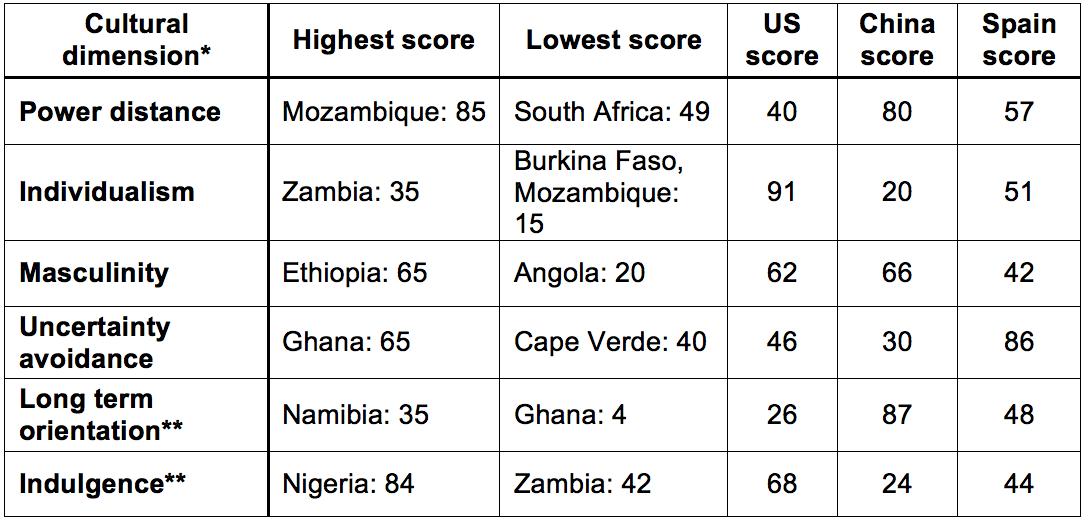As I ventured into Nigeria and Kenya, the locals warned me: “don’t think all of Africa is like us.” In fact, the number one lesson to learn about Africa is that it is not “one” place: even neighboring countries are distant. This has important implications for companies doing business in Africa and expanding in the continent: whether traditional multinationals, emerging market multinationals (EMMs), Pan-African companies, and even African regional companies.

What does country distance mean? In his CAGE model, my colleague at IESE Pankaj Ghemawat considers four types of distance: Cultural, Administrative, Geographic, and Economic. Here, I’ll focus on cultural distance, and I will deal with the other dimensions at a later time.
The Hofstede Center scores countries on a number of cultural dimensions. They provide information on 15 sub-Saharan countries (see figure below).
Some snapshots showing the differences in these countries (score range is 1-100. I include information on the US, China, and Spain for reference):
Some observations about these SSA countries, at the risk of playing down their diversity:
- all score medium to high in power distance and indulgence;
- all score about medium in uncertainty avoidance;
- all score on the low side in individualism and long-term orientation; and
- they present maximum variation in masculinity.
Let’s take a closer look at what masculinity means:
And let’s look at masculinity for SSA countries grouped by region:
At a glance:
- West African countries are the most diverse, even if all regions are heterogeneous (we don’t have enough information on Central Africa, unfortunately);
- Ethiopia, Kenya, South Africa, and Nigeria stand out as the most masculine countries: this is consistent with my casual observations that Nigerians are perceived as very aggressive, and so are Kenyans within the Eastern region; and
- Angola and Cape Verde stand out as the most feminine countries: unfortunately, I don’t have first-hand knowledge to comment on these countries.
Any thoughts on the implications for companies expanding in Africa?
* Meanings of cultural dimensions:
– Power distance: extent to which the less powerful members of institutions and organizations within a country expect and accept that power is distributed unequally;
– Individualism: degree of interdependence a society maintains among its members;
– Masculinity: extent to which a society is driven by competition, achievement and success, with success being defined by the winner / best in field;
–Uncertainty avoidance: extent to which the members of a culture feel threatened by ambiguous or unknown situations and have created beliefs and institutions that try to avoid these;
–Long-term orientation: extent to which a society maintains some links with its own past while dealing with the challenges of the present and future (high score = long term orientation = pragmatic society; low score = short term orientation = normative society).
–Indulgence: extent to which people try to control their desires and impulses (high score = weak control = indulgence; low score = high control = restraint).





Hi Africa, I was reading very carefully all your post. Great apporach!!! Even as you say, unfortunately in some African regions is very limited.
Thank you, Jose Pedro. Your posts on single African countries offer more in-depth insights to this. For those interested, take a look at https://www.linkedin.com/today/author/35892766
Dear Dr Ariño
The masculinity factor of Angola maybe it can be different, think that the first official census was in the Spring 14 and it was quiet difficult to obtain the correct information, specialy in the interior of the Country, but this factor should be higher than 20.
Algo I am working and traveling in some countries in Africa and I agree complitely with your post and maybe it could be add “even neighboring distrits/provinces into the same country are distant” also it is pretty interesting analyse the influence of portuguese , french, british, German,belgium culture and how historical cultures, like Somaly culture, right know is present in 4 countries, and also the old sudan corredor west-east that has the influence of the Otomani culture and religion.
If you want contrast any information about Angola, Cameroun, Ghana, Moçambique, Níger, Nigeria, Tanzania and Zambia, please let me know.
Pretty nice post,
Congrats,
Thank you for your comment, Alejandro.
I used the term “masculinity” in Hofsted’s sense to mean “extent to which a society is driven by competition, achievement and success, with success being defined by the winner / best in field” (explained at the very bottom of the post). My sense is that you interpreted it differently along the lines of % of male population, is that right?
I agree that within-country differences are pronounced as well, and that colonial ties have made a big difference.
And thanks for the offer to exchange ideas! I take note of it.
Totaly agree with your comment and explanation, I mistook the meaning of Mascunility.
Great Post!!
In reading your post; with which I agree completely, an article published in Management Research came to mind. The article is called “The Meaning of Difference” by Friedrich, Mesquita, and Hatum (Management Research, V. 4, No. 1 (Winter 2005) pp. 53-71. In this article the authors posed similar questions about Latin America and concluded that not all the countries, normally bunched as “Latin America” are the same. If you want to see a copy, I have it in my page and use it in my classes to show the problems of putting all countries under one label.
Thanks for a wonderful job! I agree with Jose-Pedro that it is a Great Approach.
Santiago
Santiago, thank you for bringing up the idea, and the reference. Actually, I visited Sao Paulo with a group of students last week. One of the messages we got was precisely that LatAm is not “one.” It looks like we all tend to think that our own region is diverse, but then we ignore differences in other regions. Most likely, because of lack of knowledge.